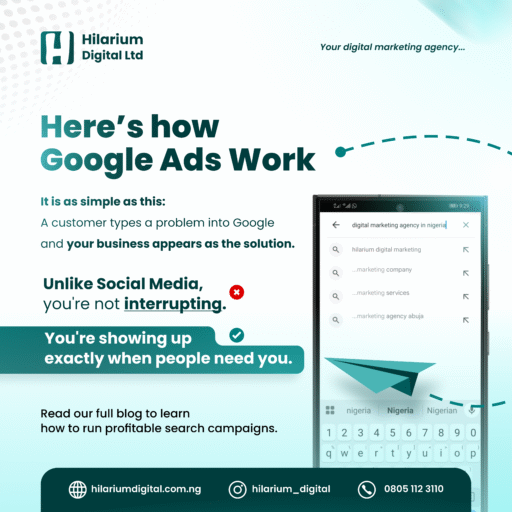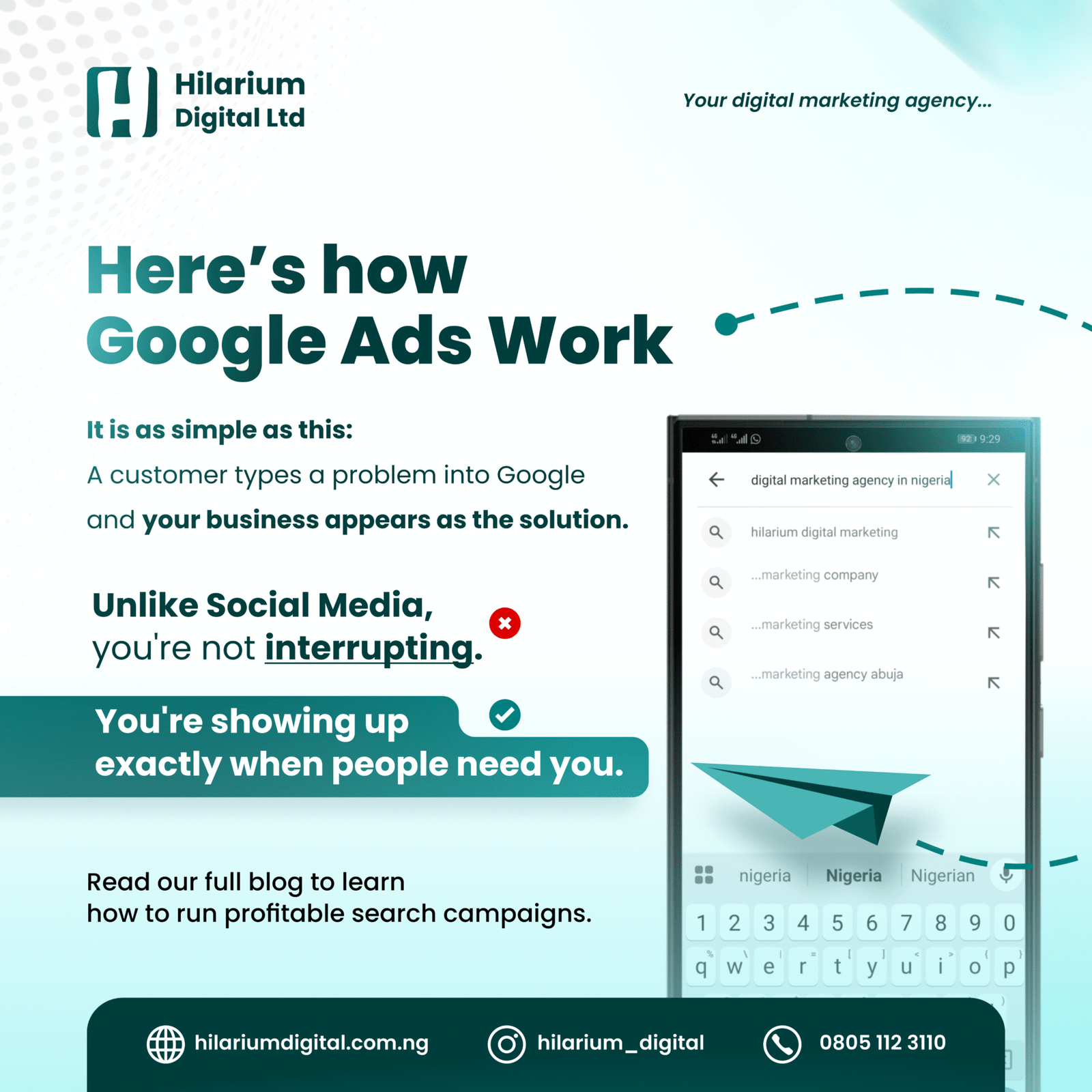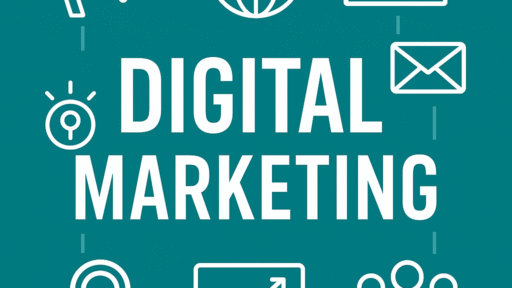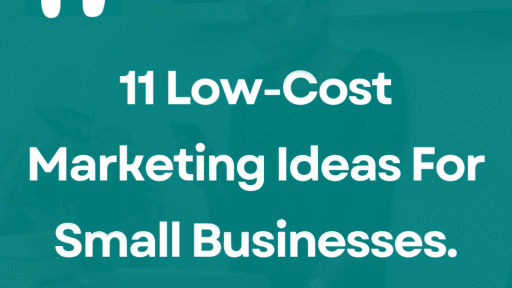Table of Contents
Introduction
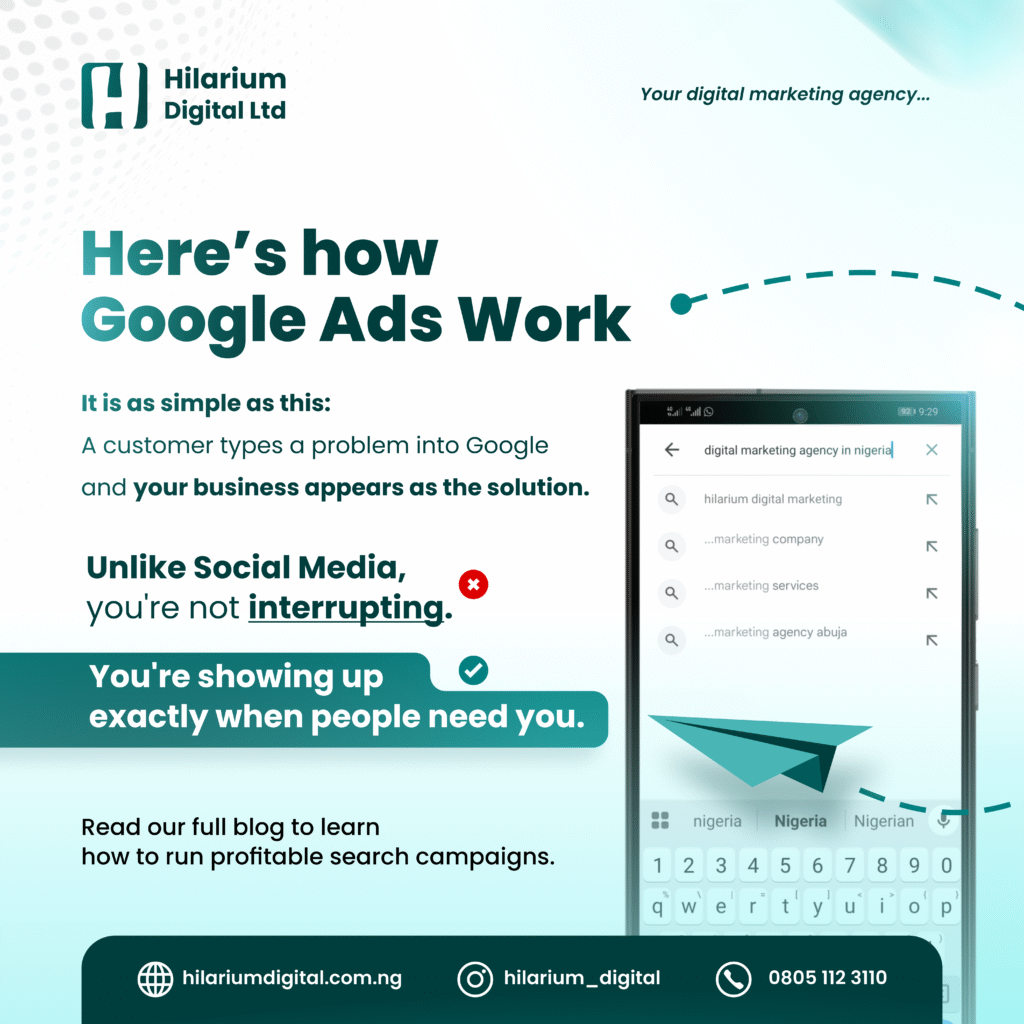
When someone types “best plumber near me” or “affordable digital marketing in Lagos” into Google, they’re expressing a clear intent to find a solution and Google Ads gives your business the opportunity to be that solution, exactly when they need it.
Unlike traditional or interruption-based advertising, search ads meet customers at the pivotal moment when they’re already seeking answers. That means higher engagement, efficiency, and when done right, a stronger return on your ad spend.
In this comprehensive guide, we’ll explore how Google Ads empowers businesses to connect with high-intent users, deliver compelling messaging, and ultimately drive conversions and ROI.
You’ll learn best practices, see real data on performance, and get expert tips plus a helpful FAQ to optimize your campaigns.
1. The Power of Google Ads: Key Statistics
ROI benchmarks: Google Ads delivers an average return on investment of 200%, meaning businesses earn approximately $2 for every $1 spent on ads. In some cases, ROI can soar as high as 800%.
Widespread adoption: Google Ads dominates the pay-per-click (PPC) market with a 69% market share, used by about 80% of businesses globally.
User engagement: Around 63% of internet users have clicked on a Google ad, demonstrating how ads reach real, engaged audiences.
Conversion performance: The average conversion rate across Google Ads campaigns sits between 3–6%, with some industries seeing rates up to 12.96% (e.g. automotive). Display vs Search breakdown: search conversion averages ~4.4%, display ~1.77%.
Ad visibility improvements: Overall ad click-through rate (CTR) increased by 3.74% year-over-year, likely due to better SERP integration with ads becoming more like organic results.
These figures underscore why Google Ads remains one of the most effective digital advertising platforms—especially when paired with intentional strategy.
2. The Three Pillars: Timing, Intent, and Conversion
To ensure your Google Ads campaigns reach customers at the right time and convert you need to optimize three core areas:
A) Target the Right Keywords (Timing & Intent)
Keyword research strategy: Start with identifying the search behaviors of your target audience. Use a mixture of short-tail keywords (e.g. “plumber”) for reach, and long-tail, high-intent keywords (e.g. “emergency plumber in Lagos open now”) for higher conversions .
Match types matter: Begin with exact or phrase match for precise targeting. As you scale, selectively test broad match. It’s improving and can drive more volume with minimal ROAS drop .
Refine with search term reports: Review real search queries that triggered your ads; add irrelevant terms as negative keywords to avoid wasted spend .
B) Match User Intent (Ad Relevance)
Quality Score: Google’s Quality Score factors in CTR, ad relevance, landing page experience, and more. It heavily influences ad rank and cost per click .
Compelling ad copy: Write ads that directly solve the user’s problem. Use concise, benefit-driven headlines and a clear Call-to-Action (CTA) e.g. “Book Today,” “Get Free Quote.” A/B test variations to optimize CTR and conversion .
Leverage ad extensions: Sitelinks, callouts, structured snippets, and call extensions enhance visibility and CTR by providing extra value to searchers .
C) Create Optimized Landing Pages (Convert)
Consistent messaging: Ensure headlines and offers on your landing page align with your ad copy. If your ad promises “24/7 plumbing help,” your landing page should immediately deliver that message .
Simplicity and speed: Avoid clutter; prioritize fast load times and user-friendly design particularly on mobile for improved conversions .
Track user behavior: Connect Google Ads with Google Analytics to analyze KPIs like CTR, conversion rate, CPA, and ROAS. This data guides smarter budget allocation and optimizations .
3. Advanced Strategies to Boost ROI
Campaign structure & segmentation: Group keywords thematically (SKAGs or well-defined ad groups) for tighter control and relevancy.
Smart bidding strategies: Use Google’s automated bidding (e.g., Target CPA, ROAS) to optimize bids in real-time based on performance data.
Targeting with first-party data + audiences: Combine your data with Google-defined audiences like demographics or behavior to reach the right customers at the right time.
AI-powered campaign types: Use newer options like Demand Gen campaigns or Performance Max (which automatically optimize creative, targeting, and bidding) for broader and often more effective reach.
Consistent optimization cadence: Follow a structured schedule daily to fix immediate issues, weekly to adjust bids and review search terms, monthly/quarterly for bigger strategic pivots.
4. FAQ – Some Google Ads Questions
1: What ROI can I realistically expect?
A – Industry averages hover around 200% ROI (i.e., $2 revenue per $1 spent) , with higher-performing campaigns reaching up to 800%. Results vary by campaign structure, industry, and optimization quality.
2: Should I use broad match keywords?
A – Yes, but with caution. Use exact and phrase match to start, then test broad match as they’re showing increasingly competitive AOV with only slightly lower ROAS.
3: What’s more powerful—Search or Display?
A – Search ads convert higher (~4–6% average), while Display is broader for awareness but lower conversion (~1.7%).
4: How often should I optimize?
A – Optimize daily for broken elements, weekly for keyword and bid adjustments, and monthly/quarterly for strategic restructures or new campaigns .
5: How do I measure ROI effectively?
A – Link Google Ads with Analytics. Monitor CTR, conversion rate, cost per acquisition (CPA), and ROAS. Refine targeting and bids based on performance insights .
6: Are ad extensions worth it?
A – Absolutely. Extensions like site links or callouts significantly boost visibility and CTR by giving searchers added information and paths .
Conclusion
Google Ads is a powerful, intent-driven channel that connects your business with customers exactly when they’re searching for what you offer. By combining targeted keyword strategy, intent-aligned ads, and conversion-oriented landing pages, you position your campaigns to deliver real ROI often double or more of what you invest.
Pair these fundamentals with advanced tools like automated bidding, AI-driven campaigns, and audience targeting, all while maintaining a disciplined optimization rhythm, and you’re setting yourself up for scalable, profitable growth.
At Hilarium Digital Limited, we specialize in crafting high-performing Google Ads campaigns that rank, convert, and deliver exceptional returns. If you’re ready to elevate your digital marketing, let’s work together to reach customers at the right time and turn clicks into customers.

